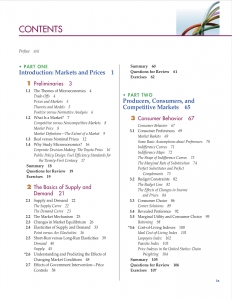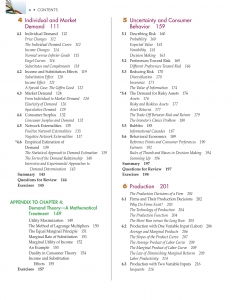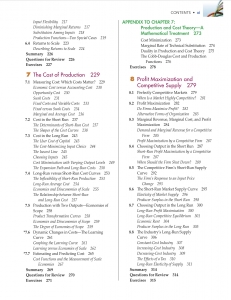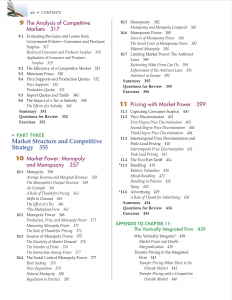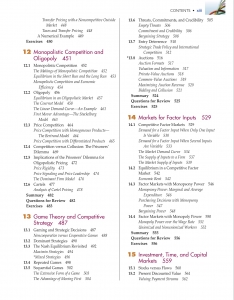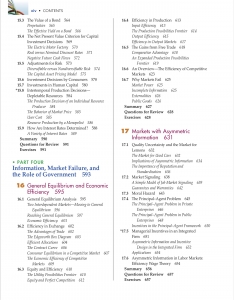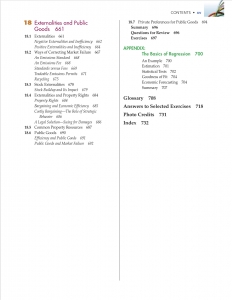Microeconomics

Email: vqmanh@hcmulaw.edu.vn
Office: Nguyen Tat Thanh Campus, Building A, Second Floor, Room A.204
Office Phone: 08.39400989 – ext: 164
Course Website: Information, assignments, and grades will be posted on Google Classroom.
1. About this Course
For students who care about how the world works, microeconomics is probably the most relevant, interesting, and important subject they can study. (Macroeconomics is the second-most important subject.) A good grasp of microeconomics is vital for managerial decision-making, designing and understanding public policy, and, more generally, appreciating how a modern economy functions. In fact, even understanding the news each day often requires knowledge of microeconomics.
The Microeconomics Course is built based on the belief that students need to be exposed to the new topics that have come to play a central role in microeconomics over the years—topics such as game theory and competitive strategy, the roles of uncertainty and information, and the analysis of pricing by firms with market power. We also felt that students need to be shown how microeconomics can help us to understand what goes on in the world and how it can be used as a practical tool for decision making. Microeconomics is an exciting and dynamic subject, but students need to appreciate its relevance and usefulness. They want and need a good understanding of how microeconomics can actually be used outside the classroom.
The course provides a treatment of microeconomic theory that stresses its relevance and application to both managerial and public policy decision-making to respond to these needs. This applied emphasis is accomplished by including examples that cover such topics as the analysis of demand, cost, and market efficiency; the design of pricing strategies; investment and production decisions; and public policy analysis.
There have been dramatic changes that have occurred in the field in recent years. There has been growing interest in game theory and the strategic interactions of firms (Chapters 12 and 13), in the role and implications of uncertainty and asymmetric information (Chapters 5 and 17), in the pricing strategies of firms with market power (Chapters 10 and 11), and in the design of policies to deal efficiently with externalities such as environmental pollution (Chapter 18).
The course is comprehensive and up to date does not mean that it is “advanced” or difficult. We believe that the study of microeconomics should be enjoyable and stimulating.
2. Prerequisites and Preparation
This course will include some basic univariate calculus material, as taught in the ULAW course “Advanced Mathematics” or a comparable high-school calculus course. There are no other prerequisites.
3. Course Goals of Principles of Microeconomics Course
Principles of Microeconomics is an introductory undergraduate course that teaches the fundamentals of microeconomics. At ULAW, this is the first course that undergraduates take in economics. It provides a solid foundation for economic analysis and thinking that can last throughout their education and subsequent professional careers.
This course introduces supply and demand and the basic forces that determine equilibrium in a market economy. Next, it introduces a framework for learning about consumer behavior and analyzing consumer decisions. We then turn our attention to firms and their decisions about optimal production.
By the end of the course, you will understand the introductory microeconomic theory, solve basic microeconomic problems, and use these techniques to think about several policy questions relevant to the operation of the real economy.
After completing the Principles of Microeconomics Course, students should have developed a range of skills to understand economic concepts and use those concepts to analyze specific questions.
By the end of this course, students should be able to:
• Understand consumer behavior.
• Understand firm behavior.
• Understand how to apply economic principles to a range of policy questions.
Students should also have the skills needed to:
• Use supply and demand diagrams to analyze the impact of overall changes in supply and demand on price and quantity.
• Solve a consumer’s utility maximization problem mathematically and graphically; analyze the impact of changes in price and income on a consumer’s decision via shifting income and substitution effects.
• Understand the consumer’s labor supply decision.
• Solve a firm’s cost minimization problem mathematically and graphically.
• Analyze the behavior of firms in a perfectly competitive market in the short-run and the long run.
4. Course Components and Requirements
• Assigned readings
• Lectures
• 6 Handouts
• 6 Matching Definition Quizzes
• 6 Practice Problem Sets
• Midterm Exam
• Final Exam
Matching Definition Quizzes: The Quiz tests students’ ability to distinguish new concepts in the new chapter. Every Quiz will be done before starting a new chapter to guarantee that students are well-prepared for the new chapter.
Practice Problem Sets: At the end of each chapter, several practice problems help students review and reinforce the material covered in the lectures.
Assigned Readings: Readings are assigned for each lecture
Required Materials: The required textbook is “Microeconomics” (Eighth Edition) by Robert S. Pindyck and Daniel L. Rubinfeld.
Handouts: Each lecture and most graphical supplements have an accompanying handout with key terms and graphs that students can use to take notes or mark up graphs.
5. Deliverables and Grading
There will be six problem sets and six matching definition quizzes, which will be done in groups. At the end of the term, groups will have the best five grades cumulated up, which will count for 10% of the final course grade.
Attendance and Participation: These will count for 30% of the final course grade.
There will be a midterm exam covering chapter 1 và 2. This will cover roughly 10% of the course material, will be 2 hours long.
There will also be a two-hour final, which will be cumulative and cover chapters 3,4,5 and 6. This will count as the remaining 50% of the grade.
Grades will be posted on Google Classroom. Students are expected to regularly check Google Classroom and discuss any issues regarding grades with the instructor as soon as possible. If a grade has not been contested within one week of being posted, the grade stands and will not be changed.
Tiếng Việt
I. NỘI DUNG HỌC PHẦN
Môn Kinh tế học vi mô nghiên cứu hành vi của các chủ thể kinh tế trong thị trường đối với việc ra quyết định phân bổ hiệu quả các nguồn lực khan hiếm. Môn học tập trung vào động cơ, cách thức ra quyết định của các chủ thể này và ảnh hưởng của các quyết định đến các chủ thể khác cũng như tổng thể nền kinh tế.
Nội dung môn học này gồm có bốn phần chính. Trong phần đầu sẽ giới thiệu các vấn đề mà kinh tế học vi mô đề cập đến và những câu trả lời có thể đưa ra. Phần này cũng giải thích thị trường là gì, làm thế nào để chúng ta xác định các ranh giới của một thị trường và chúng ta đo lường giá cả thị trường như thế nào. Phần thứ hai sẽ trình bày một trong những công cụ quan trọng nhất của kinh tế học vi mô: phân tích cung cầu. Phần này sẽ giải thích cách thức một thị trường cạnh tranh hoạt động và cung cầu xác định giá cả như thế nào. Chúng ta sẽ phân tích cách cung cầu được sử dụng để xác định tác động của các cú sốc trên thị trường, bao gồm cả can thiệp của chính phủ. Phần thứ ba của môn học xem xét cách thức người tiêu dùng ra quyết định mua sắm, nghiên cứu sở thích và sự giới hạn ngân sách của người tiêu dùng. Phần thứ tư là nghiên cứu về hành vi của doanh nghiệp theo một trình tự logic từ lý thuyết sản xuất đến lý thuyết về chi phí. Phần này cũng nghiên cứu nguyên tắc tối đa hoá lợi nhuận và xây dựng đường cung của doanh nghiệp và đường cung thị trường trong một ngành cạnh tranh.
II. MỤC TIÊU CỦA HỌC PHẦN
Về kiến thức:
Học xong học phần Kinh tế học vi mô, sinh viên có khả năng:
– Áp dụng được các khái niệm, nguyên lý, và công cụ của kinh tế học vi mô trong việc ra quyết định quản lý trong các công ty thuộc các ngành kinh tế khác nhau;
– Hiểu bản chất nhiều vấn đề kinh tế được thảo luận trên các phương tiện thông tin đại chúng;
– Áp dụng kiến thức của môn học để thiết kế và hiểu chính sách của Chính phủ;
– Sử dụng kiến thức nền tảng của kinh tế học vi mô cho các môn học chuyên ngành sau này.
Về kỹ năng:
Các lớp Chất Lượng Cao tăng cường tiếng Anh đặc biệt nhấn mạnh rèn luyện các Kỹ năng nghề nghiệp sau:
– Kỹ năng thuyết trình, diễn đạt tự tin trước đám đông;
– Kỹ năng tranh luận và bảo vệ quan điểm.
– Kỹ năng cộng tác, làm việc nhóm và điều phối nhóm (Thảo luận về nội dung bài học trước khi đến lớp; tham gia giải quyết nhiệm vụ làm việc nhóm trong suốt buổi học).
– Kỹ năng lắng nghe, ghi chú ý chính với tư duy phê phán thông qua việc đặt câu hỏi cho nhóm khác và giảng viên. Qua đó rèn kỹ năng phát hiện vấn đề và đặt câu hỏi.
– Kỹ năng tư duy độc lập, sáng tạo.
– Kỹ năng tự học, đọc tài liệu và tự cập nhật kiến thức mới thông qua quá trình đọc tài liệu ở nhà.
– Kỹ năng thu thập thông tin, kỹ năng tổng hợp, hệ thống hoá các vấn đề liên quan tới môn học.
– Kỹ năng so sánh, phân tích, bình luận, đánh giá.
Về thái độ:
Các lớp Chất Lượng Cao tăng cường tiếng Anh đặc biệt nhấn mạnh rèn luyện Thái độ làm việc mà doanh nghiệp cần như sau:
– Thái độ chủ động, tích cực trong học tập cũng như công việc tương lai.
– Thái độ cầu tiến và ham học hỏi.
– Có trách nhiệm và ý thức tự giác với công việc và nhiệm vụ được giao thông qua nhiệm vụ đọc tài liệu ở nhà, làm bài tập nhóm và đóng góp vào hoạt động thảo luận của nhóm trên lớp.
– Rèn luyện kỷ luật và thái độ lao động thông qua việc đi học đầy đủ đúng giờ.
– Có ý thức đúng đắn trong việc nhìn nhận, đánh giá đường lối, chính sách, pháp luật kinh tế của Chính phủ trong điều kiện kinh tế thị trường có sự điều tiết của Nhà nước.
Đường dẫn các Video bài giảng trực tuyến môn Kinh tế học vi mô
Chương 1: Bao gồm 4 Video sau:
1. Vì sao học Kinh tế học vi mô?, https://youtu.be/Fl2CBWEbUNs
2. Hướng dẫn ôn tập các câu hỏi về Chi phí cơ hội, https://youtu.be/03Hd3PEA65A
3. Hướng dẫn ôn tập các câu hỏi về Phạm vi thị trường, https://youtu.be/hdeCkzNggt8
4. Hướng dẫn ôn tập các câu hỏi về Giá thực và Giá danh nghĩa, https://youtu.be/yOzXgpsBAb0
Chương 2: Bao gồm 6 Video sau:
1.‘Nghịch lý kim cương và nước’ & ‘Phân tích thị trường hoa hồng’, https://youtu.be/hA37fLgTVTc
2. Xây dựng bản đồ Mind Map về Sự co giãn của Cung và Cầu, https://youtu.be/nbW_8RBgpCM
3. Hướng dẫn ôn tập các câu hỏi về Phần Cung cầu – Định tính, https://youtu.be/m3Ai3BhNhvQ
4. Hướng dẫn ôn tập các câu hỏi về Phần Cung cầu – Định tính (Tiếp), https://youtu.be/jQ4c2ooj5L0
5. Hướng dẫn ôn tập các câu hỏi về Phần Cung cầu – Định lượng, https://youtu.be/_Y452ChvXS4
6. Hướng dẫn ôn tập các câu hỏi về Phần Cung cầu – Định lượng (Tiếp), https://youtu.be/8bDvAyJOTcw
Chương 3: Bao gồm 7 Video sau:
1. Hành vi người tiêu dùng – Phần 1, https://youtu.be/QDhB9oeYwMA
2. Hành vi người tiêu dùng – Phần 2, https://youtu.be/3eXkZG3nZ4k
3. Hướng dẫn ôn tập các câu hỏi về Lý thuyết hành vi người tiêu dùng (Phần 1), https://youtu.be/i3DBGWqZ9uA
4. Hướng dẫn ôn tập các câu hỏi về Lý thuyết hành vi người tiêu dùng (Phần 2), https://youtu.be/1SzebFf-nCg
5. Hướng dẫn ôn tập các câu hỏi về Lý thuyết hành vi người tiêu dùng (Phần 3), https://youtu.be/1SzebFf-nCg
6. Hướng dẫn ôn tập các câu hỏi về Lý thuyết hành vi người tiêu dùng (Phần 4), https://youtu.be/a8olSoYvrtY
7. Hướng dẫn ôn tập các câu hỏi về Lý thuyết hành vi người tiêu dùng (Phần 5), https://youtu.be/M26dmUxM2AI
Chương 4: Bao gồm 3 Video sau:
1. Lý thuyết sản xuất, https://youtu.be/FyUNRejvt3o
2. Hướng dẫn ôn tập câu hỏi về Lý thuyết sản xuất (Phần 1), https://youtu.be/6XNDmfKapsc
3. Hướng dẫn ôn tập câu hỏi về Lý thuyết sản xuất (Phần 2), https://youtu.be/FWeXcPicM5k
Chương 5: Bao gồm 3 Video sau:
1. Chi phí sản xuất, https://youtu.be/4rw1e3UZa8U
2. Hướng dẫn ôn tập câu hỏi về Lý thuyết chi phí (Phần 1), https://youtu.be/Cf97J_2FNBE
3. Hướng dẫn ôn tập câu hỏi về Lý thuyết chi phí (Phần 2), https://youtu.be/VaItBPQPGeE







